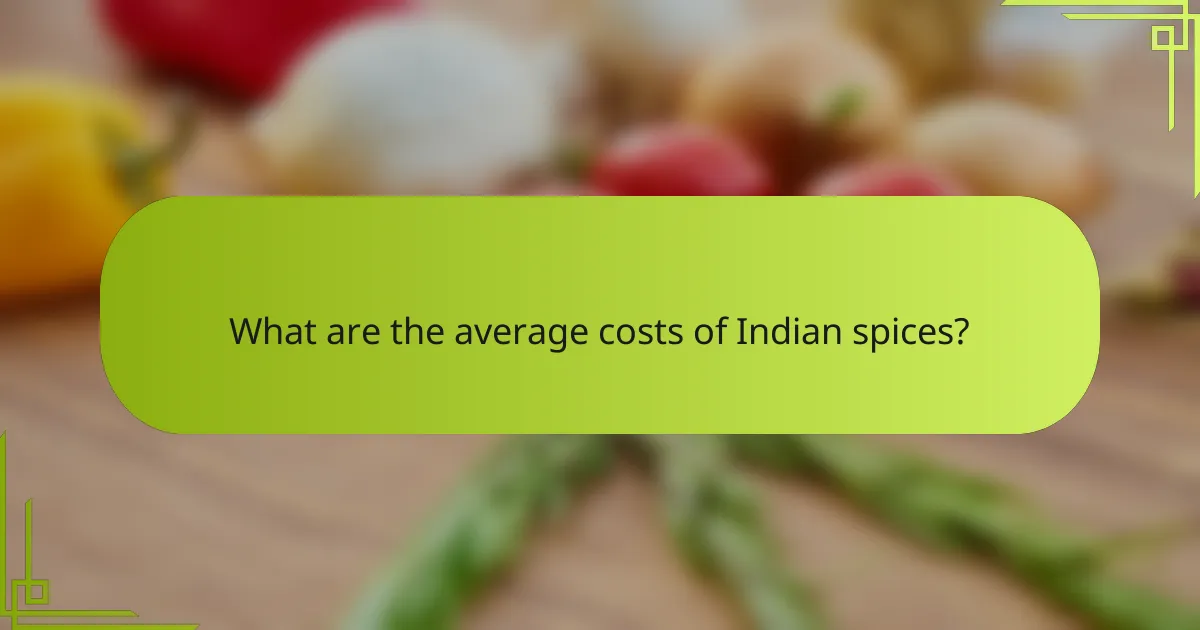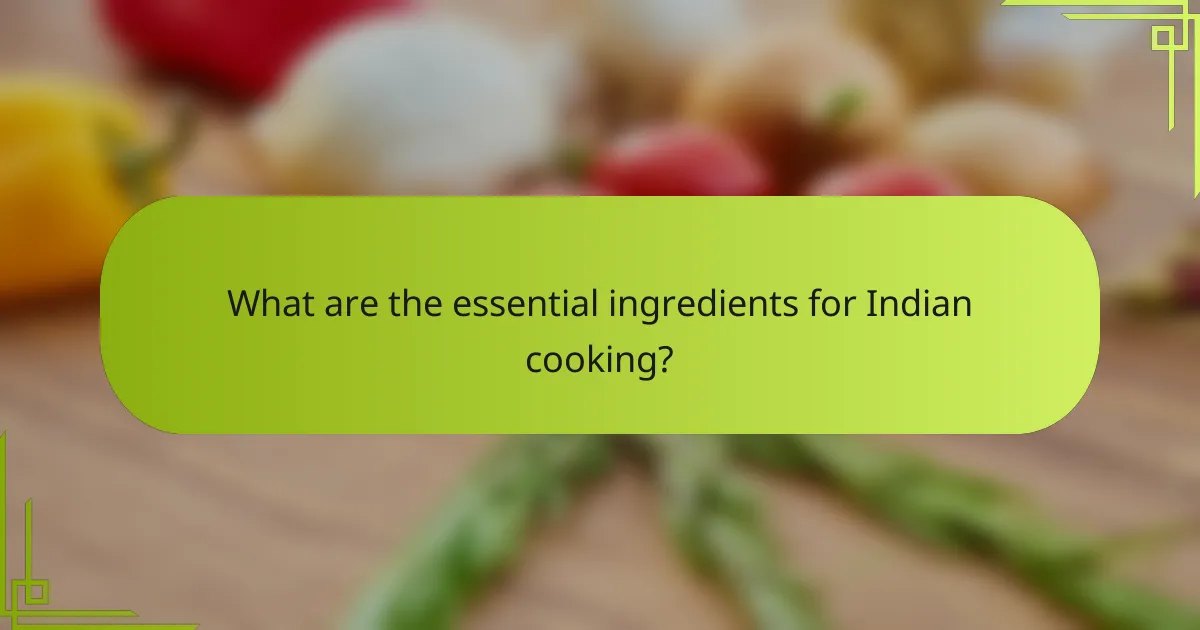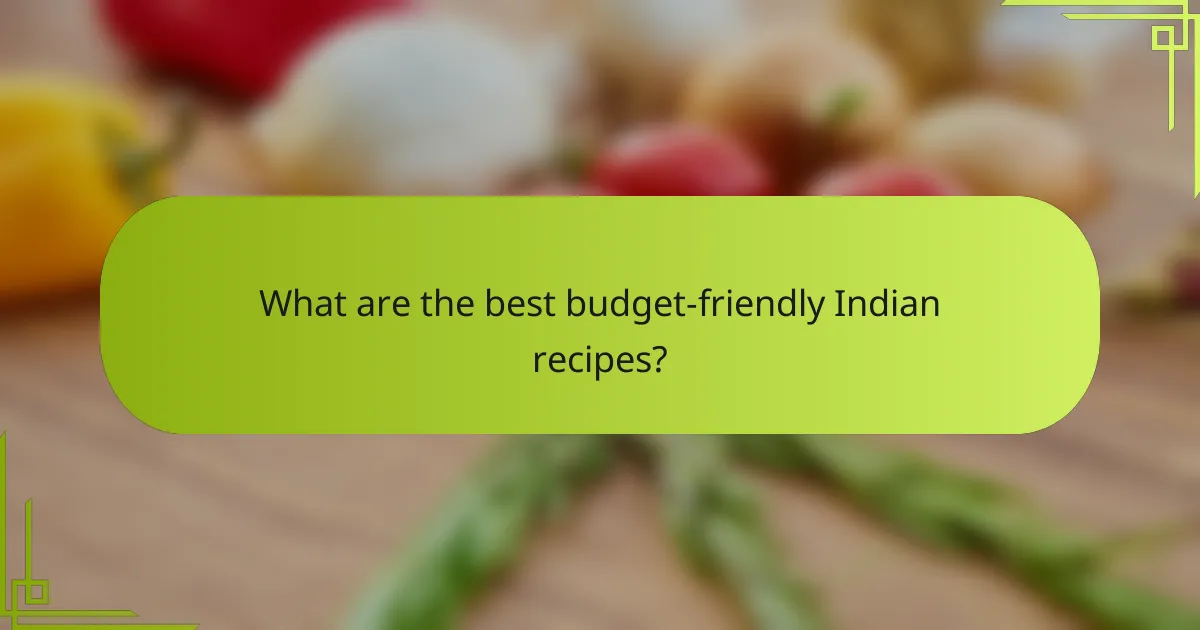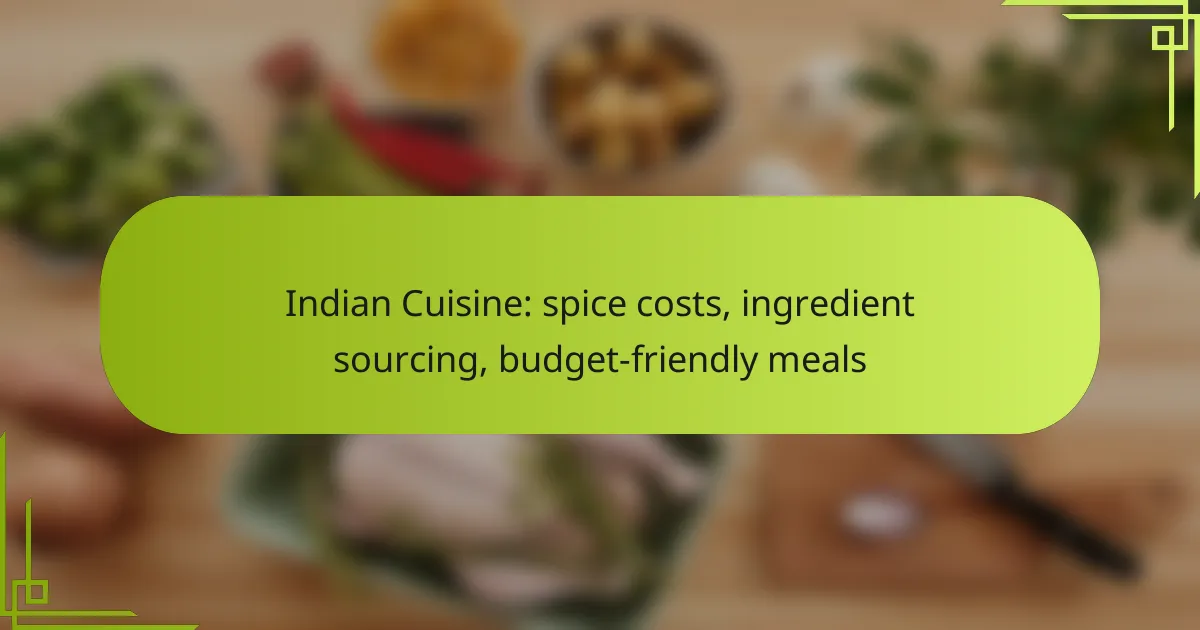Exploring Indian cuisine can be both rewarding and economical, especially when it comes to sourcing spices and ingredients. By understanding the costs associated with various spices and utilizing budget-friendly recipes, you can create flavorful meals without breaking the bank. With the right approach to ingredient selection and meal planning, enjoying authentic Indian dishes becomes accessible to everyone.

How to source spices for Indian cuisine in the UK?
Sourcing spices for Indian cuisine in the UK can be done effectively through various channels, including local stores and online retailers. Understanding where to find quality spices at reasonable prices is key to enhancing your cooking experience.
Local Indian grocery stores
Local Indian grocery stores are often the best place to find authentic spices. These shops typically carry a wide range of spices, including staples like cumin, coriander, and turmeric, often at competitive prices. You can expect to pay anywhere from £1 to £5 for small packets, depending on the spice.
Shopping at these stores not only supports local businesses but also allows you to ask for recommendations and tips from knowledgeable staff. Look for stores in areas with a significant South Asian community for the best selection.
Online spice retailers
Online spice retailers provide convenience and a broader selection of spices that may not be available locally. Websites like Amazon or specialized spice shops can offer bulk options, which can be more economical if you cook frequently. Prices can vary widely, typically ranging from £2 to £10 for various spice quantities.
When purchasing online, check customer reviews and product descriptions to ensure quality. Look for retailers that offer organic or sustainably sourced options for a healthier choice.
Farmers’ markets
Farmers’ markets can be a great source for fresh spices and herbs, often sold by local producers. While you may find fewer traditional Indian spices, you can discover unique blends and fresh ingredients that enhance Indian dishes. Prices at farmers’ markets can be slightly higher, often between £2 and £6 per item.
Visiting these markets also supports local agriculture and allows you to engage directly with growers, who can provide insights into their products and growing methods.
Specialty food shops
Specialty food shops often carry a curated selection of spices, including those used in Indian cuisine. These shops might focus on organic or gourmet products, which can be pricier, typically ranging from £3 to £10. However, the quality and unique offerings can justify the cost.
When shopping at specialty food shops, look for unique spice blends or rare ingredients that can elevate your dishes. Don’t hesitate to ask staff for recommendations based on your cooking needs.

What are the average costs of Indian spices?
The average costs of Indian spices can vary significantly based on the type, quality, and sourcing methods. Generally, spices can range from a few dollars to over twenty dollars per kilogram, depending on these factors.
Common spice price ranges
Common Indian spices like turmeric, cumin, and coriander typically cost between $3 to $10 per kilogram when purchased in bulk. More exotic spices, such as saffron and cardamom, can range from $20 to $50 per kilogram, reflecting their rarity and labor-intensive harvesting processes.
Buying spices in smaller quantities from local markets may lead to higher per-unit costs, but it allows for fresher options and reduced waste. For everyday cooking, consider purchasing staple spices in bulk to save money.
Factors affecting spice costs
Several factors influence the costs of Indian spices, including quality, origin, and market demand. Organic and premium-grade spices tend to be pricier due to their cultivation methods and certification processes.
Additionally, seasonal variations and global supply chain issues can impact prices. For instance, if a particular spice is in high demand or if there are disruptions in production areas, prices may rise significantly.

How to create budget-friendly Indian meals?
Creating budget-friendly Indian meals involves selecting cost-effective ingredients and utilizing simple recipes that maximize flavor without overspending. By making smart substitutions and planning meals effectively, you can enjoy delicious Indian cuisine without straining your wallet.
Affordable ingredient substitutions
When cooking Indian meals on a budget, consider substituting expensive ingredients with more affordable options. For instance, instead of using saffron, which can be pricey, try turmeric for color and flavor. Similarly, if fresh herbs like cilantro are out of reach, dried herbs can still provide a good taste at a lower cost.
Common substitutions include using canned tomatoes instead of fresh ones, which can save money and time. For proteins, consider legumes like lentils or chickpeas, which are not only budget-friendly but also nutritious and filling.
Simple recipes for budget meals
Simple recipes are key to budget-friendly Indian meals. Dishes like dal (lentil soup) and vegetable curry can be made with inexpensive ingredients and are easy to prepare. A basic dal recipe requires just lentils, water, and spices like cumin and turmeric, making it both economical and satisfying.
Another budget-friendly option is aloo gobi, a potato and cauliflower dish that uses minimal ingredients. With potatoes, cauliflower, and a few spices, you can create a hearty meal that serves multiple people without breaking the bank.
Meal planning tips
Effective meal planning can significantly reduce food costs. Start by creating a weekly menu that incorporates seasonal vegetables and grains, which are often cheaper. Aim to batch cook meals like curries or rice dishes that can be easily reheated throughout the week.
Additionally, keep an eye on local markets for sales on bulk items, such as rice or lentils, which can lower costs. Make a shopping list based on your meal plan to avoid impulse purchases and stick to your budget.

What are the essential ingredients for Indian cooking?
Essential ingredients for Indian cooking include a variety of spices, herbs, vegetables, and legumes that contribute to the rich flavors and aromas characteristic of the cuisine. Understanding these ingredients is key to creating authentic Indian dishes while also considering sourcing and cost.
Staple spices and herbs
Staple spices in Indian cooking include cumin, coriander, turmeric, and garam masala, each offering unique flavors and health benefits. These spices can typically be found in local markets or grocery stores, often at reasonable prices, ranging from a few dollars for small packets to larger quantities for under ten dollars.
Herbs such as cilantro and mint are also essential, adding freshness to many dishes. When sourcing spices, consider buying in bulk or from specialty stores to save costs and ensure quality.
Common vegetables and legumes
Common vegetables in Indian cuisine include potatoes, onions, tomatoes, and spinach, which are often used in various curries and side dishes. These ingredients are generally affordable and widely available in markets, with prices varying based on seasonality and region.
Legumes like lentils, chickpeas, and kidney beans are staples that provide protein and fiber. Purchasing dried legumes can be more economical than canned options, with prices typically ranging from a few dollars per kilogram. Incorporating these ingredients into meals can help create budget-friendly options without sacrificing flavor.

How to choose quality ingredients for Indian dishes?
Choosing quality ingredients for Indian dishes involves selecting fresh produce and ensuring spices are at their peak freshness. This not only enhances the flavor but also contributes to the overall healthiness of the meal.
Identifying fresh produce
Fresh produce is essential for authentic Indian cooking. Look for vibrant colors, firm textures, and a pleasant aroma when selecting vegetables and fruits. For instance, tomatoes should be bright red and slightly firm, while leafy greens should be crisp and free from wilting.
When shopping, consider visiting local markets where produce is often fresher than in supermarkets. Buying seasonal fruits and vegetables can also be more economical and flavorful, as they are harvested at their peak ripeness.
Understanding spice freshness
Spice freshness significantly impacts the flavor profile of Indian dishes. Whole spices tend to retain their potency longer than ground spices, so opt for whole spices whenever possible and grind them as needed. Check for a strong aroma when purchasing spices; if they lack scent, they may be stale.
Store spices in airtight containers away from light and heat to maintain their freshness. Regularly check your spice inventory and replace any that have lost their aroma or color, as this can diminish the quality of your dishes. Aim to use spices within six months to a year for optimal flavor.

What are the best budget-friendly Indian recipes?
Some of the best budget-friendly Indian recipes include Dal Tadka, Vegetable Biryani, and Chana Masala. These dishes are not only affordable but also nutritious and flavorful, making them ideal for anyone looking to enjoy Indian cuisine without overspending.
Dal Tadka
Dal Tadka is a simple yet delicious dish made from lentils, typically yellow split peas or red lentils, cooked with spices. It is a staple in many Indian households and can be prepared for just a few dollars, depending on the type of lentils used.
To make Dal Tadka, cook the lentils until soft, then temper them with cumin seeds, garlic, and spices like turmeric and chili powder. Serve it with rice or flatbreads for a complete meal. This dish is rich in protein and fiber, making it a healthy choice.
Vegetable Biryani
Vegetable Biryani is a fragrant rice dish cooked with mixed vegetables and aromatic spices. It is a versatile recipe that allows you to use whatever vegetables you have on hand, keeping costs low.
To prepare Vegetable Biryani, sauté onions, garlic, and ginger, add chopped vegetables, and then layer with partially cooked basmati rice. Cook everything together with spices like cardamom and cloves. This dish can be made for under ten dollars and is perfect for feeding a family.
Chana Masala
Chana Masala is a hearty chickpea curry that is both filling and budget-friendly. Chickpeas are inexpensive and packed with protein, making this dish a popular choice for vegetarians and vegans.
To cook Chana Masala, soak and boil chickpeas, then simmer them with tomatoes, onions, and spices such as garam masala and coriander. This dish can be served with rice or naan and typically costs around five to eight dollars to prepare, depending on the ingredients used.










